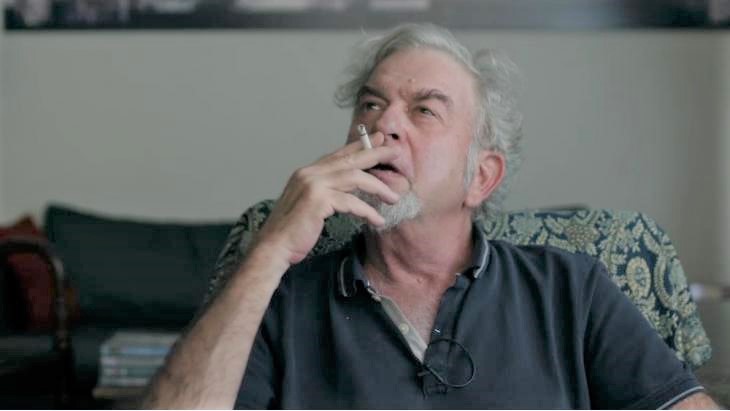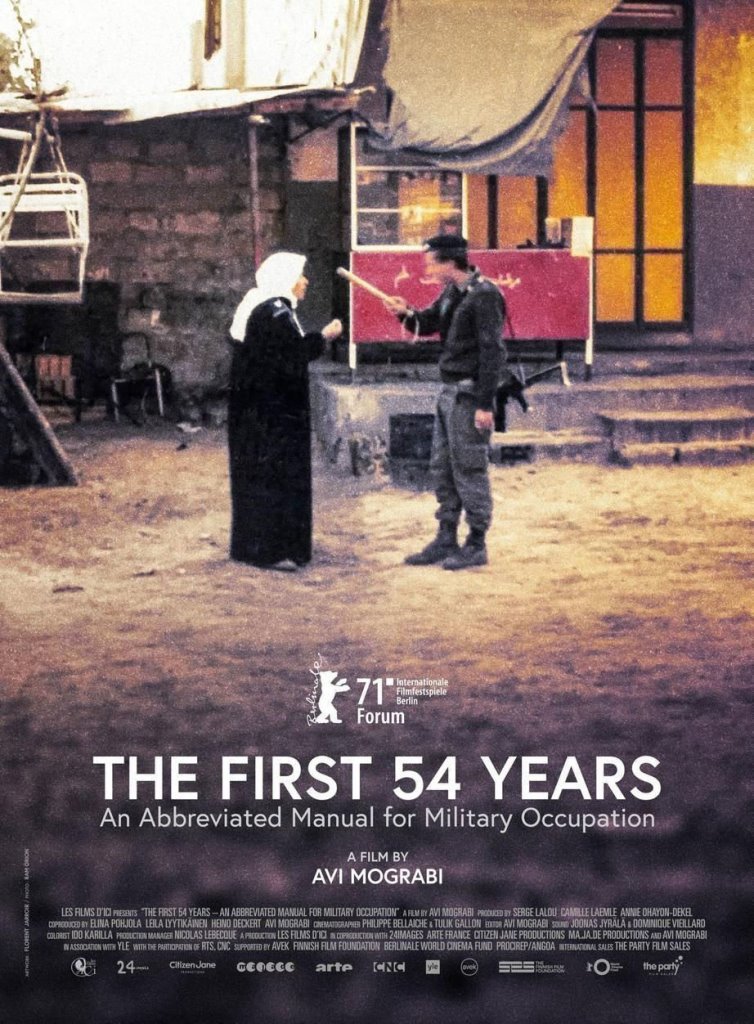A "manual for the occupation"

Avi Mograbi sits in his chair like a storyteller. In his hand he holds a book, a fictitious "manual for military occupation". From time to time, Mograbi smokes a cigarette, though arguably a pipe would have suited his face better. His calmly stated, often imploring "instructions for successful occupiers" are supplemented by shocking testimonies from Israeli soldiers.
For the film, Mograbi draws on comprehensive material from Israeli NGO Breaking the Silence. Since 2004, the organisation has been collecting witness testimonies from members of the Israeli military deployed in occupied regions. Sometimes anonymous, but often using their full names, former soldiers speak of minor misdeeds and the gravest of human rights violations. In doing so, the organisation hopes to show the Israeli public that these violations are not a matter of individual wrongdoing, they are the result of long years of occupation and a permanently established system of injustice that must be brought to an end.
This is what matters to Mograbi, too. His "manual for occupation" groups witness testimonies collected by Breaking the Silence into chapters according to chronology and content. In doing so, he hopes to get to the bottom of the question of how it is possible to sustain a state of occupation for over 54 years.
Grim irony
Breaking the Silence has been subjected to serious attacks in Israel, and has long been a bogeyman of the Israeli Right. In 2017, Netanyahu and his supporters attempted to prevent the then German foreign minister Sigmar Gabriel from meeting with Breaking the Silence and the prominent Israeli human rights organisation, Btselem – but were ultimately unsuccessful.

Breaking the Silence has been subjected to serious attacks in Israel, and has long been a bogeyman of the Israeli Right. In 2017, Netanyahu and his supporters attempted to prevent the then German foreign minister Sigmar Gabriel from meeting with Breaking the Silence and the prominent Israeli human rights organisation, Btselem – but were ultimately unsuccessful.
Breaking the Silence was challenged in Germany, too. Those seeking to prevent any criticism from the Israeli left, however, are contributing directly to the elimination of Israeli democracy. This, at a time when the elections on 23 March will see Netanyahu co-operating with a party that considers itself to be following in the footsteps of Meir Kahane’s outlawed far-right Kach Party. Meanwhile, classic supporters of a two-state solution and critics of Israeli settlement policies, such as the Meretz Party, are worried whether they will gain any seats in the Knesset at all.
Israeli artists who, like Mograbi, have the courage to denounce the system of occupation ought therefore to command the greatest of respect. They are beacons of Israeli democratic culture, yet the criticism they face from supposed friends of Israel is immense. Such negative attention has focused particularly on Mograbi, whose film exudes irony. Anyone wanting to occupy a country, so his theory goes, could learn a lot from the Israeli occupation.
In Chapter 1, ("First Steps 1967-87"), he advises occupiers not to lose sight of their goal: the first settlers moved into the West Bank in 1967. Anyone wanting to appropriate occupied land must begin the transfer of the population as quickly as possible. "Furthermore, " Mograbi quotes from his ‘manual’, "It is important to prevent refugees from returning." 250,000 people fled the West Bank during the war of 1967, a fifth of the population at the time. As with everything in Mograbi’s manual, their flight is illustrated with real-life testimonies from former Israeli soldiers.
A life devoid of civil rights
Another ingredient in Mograbi’s fatalistic recipe for success is the "normalisation" of occupation. "The living standards of the occupied population must be improved such that they have something to lose. Ideally, work permits should be issued in the occupying country." It must be clear, however, who is issuing the rules and that they must be followed. Protests and resistance must be crushed at any price. To this end, it is important to undermine solidarity amongst members of the occupied population and destroy the social framework. A network of informants could serve as a means by which to achieve this, as could selective punishment of particular villages, families and individuals.
The witness testimonies from former soldiers reveal that Mograbi’s bitter recommendations do not spring from his imagination. In the occupied areas, the Israeli army is despotic in its actions. In contrast to the settlers, described as the Israeli Right, the entire Palestinian population is living under martial law. In 2019, Human Rights Watch documented how this system of gradual disenfranchisement in its impressive report, “Born without Civil Rights”. Should a case go to court, both judges and public defenders are supporters of the Israeli army. Before the military court, Palestinians are handed arbitrary judgements for trivial misdeeds, such as parking misdemeanours or not having paid their electricity bill. There is no civil procedure.
Mograbi’s cynical "recommendations" expose the Israeli occupation’s real-life playbook and suggest that a clear strategy had been pursued from the outset. Individual acts from the soldiers’ curated witness testimonies are incorporated into this overarching plan. In 1978, there were only 120 settlements with 50,000 settlers in the West Bank. Today, there are over 600,000 settlers.
The Palestinians’ frustration with the lasting occupation came to a head in the first Intifada in 1987. This is where Mograbi begins his second phase, covering 1987-2000, which he titles "A Loss of Control". The Israeli reaction to the protests was brutal. Two-time president and architect of the later Oslo Accords Yitzhak Rabin advised his soldiers to "break [the Palestinians’] arms and legs" and the soldiers’ statements confirm that they took this entirely literally. Some of the soldiers still have their army batons, which they were to use to bludgeon back any shows of resistance.
A society traumatised by despotism
"What matters now," Mograbi whispers to the camera again imploringly, "is that dominance is restored. Dominance over bodies, both individual and collective." Such an aim requires mass arrests, he says: "When you arrest a person, you send a message to their family, to their entire community."
Indeed, 40 percent of the male Palestinian population have been imprisoned at some time or other. It is as if Palestinians are assumed to be criminals, and it has become quite normal that in every family, uncles, fathers or sons (it is usually the men) are absent for years at a time. But it is not remotely normal; it is traumatising and corrosive to society – and, in accordance with Mograbi’s bleak manual, achieves its aim.
In this analysis, the years of the Oslo Peace Process offered no glimmer of hope; instead, they ultimately led to the consolidation of the occupation. They were expressed in a complex and sometimes mind-boggling system of road closures, checkpoints, issue and revocation of permits, and the concession of privileges in occupied areas. In Mograbi’s reading of the situation, it is at this point that despotism really becomes a systematic instrument of power.
Soldiers tell of nightly house raids, the sole purpose of which was to send a message that they could turn up anywhere, at any time. The traumatising effects of these house raids were most recently analysed by the Israeli human rights organisations Breaking the Silence, Yesh Din and Physicians for Human Rights in a comprehensive report.
Mograbi titles the final chapter, "A Complete Loss of Control", which comprises the period from 2000 to the present day. Even the manual has no response to Palestinian suicide attacks and the unbounded violence and counterforce witnessed in the second Intifada of 2000. Over 4000 people died, 950 Israelis and 3200 Palestinians. Vengeance and despotism are becoming par for the course. By now, it is clear: Mograbi’s "manual for occupation" is a catastrophe, a veritable recipe for disaster. What seems cynical at first is actually an attempt to examine the occupation at its very heart.
Mograbi leaves his viewer with little cause for optimism, even if it is as yet unclear as to whether the country can ultimately be annexed. With Trump, the Israeli Right’s dream of a formal annexation of large parts of the West Bank was almost realised. The film ends with the Gaza wars of 2008 ("Operation Cast Lead") and 2014, which are afforded little space in discourse, though Breaking the Silence has documented particularly severe offences relating to these. Many Israeli observers fear that many more dark chapters will be added to the "manual for occupation", such as the expulsion of the population living in the occupied areas.
But there is also an international level that Mograbi, for whom the film is inherently an Israeli inside view, does not discuss. Here, other things matter beyond his "manual for occupation": the Geneva Convention, for one. The International Criminal Court has just decided to begin investigations into Israeli and Palestinian crimes in the occupied areas. In this respect, there is still hope that, in the future, there will be accountability for all victims of violence – on both sides.
© Qantara.de 2021
Translated from the German by Ayca Turkoglu